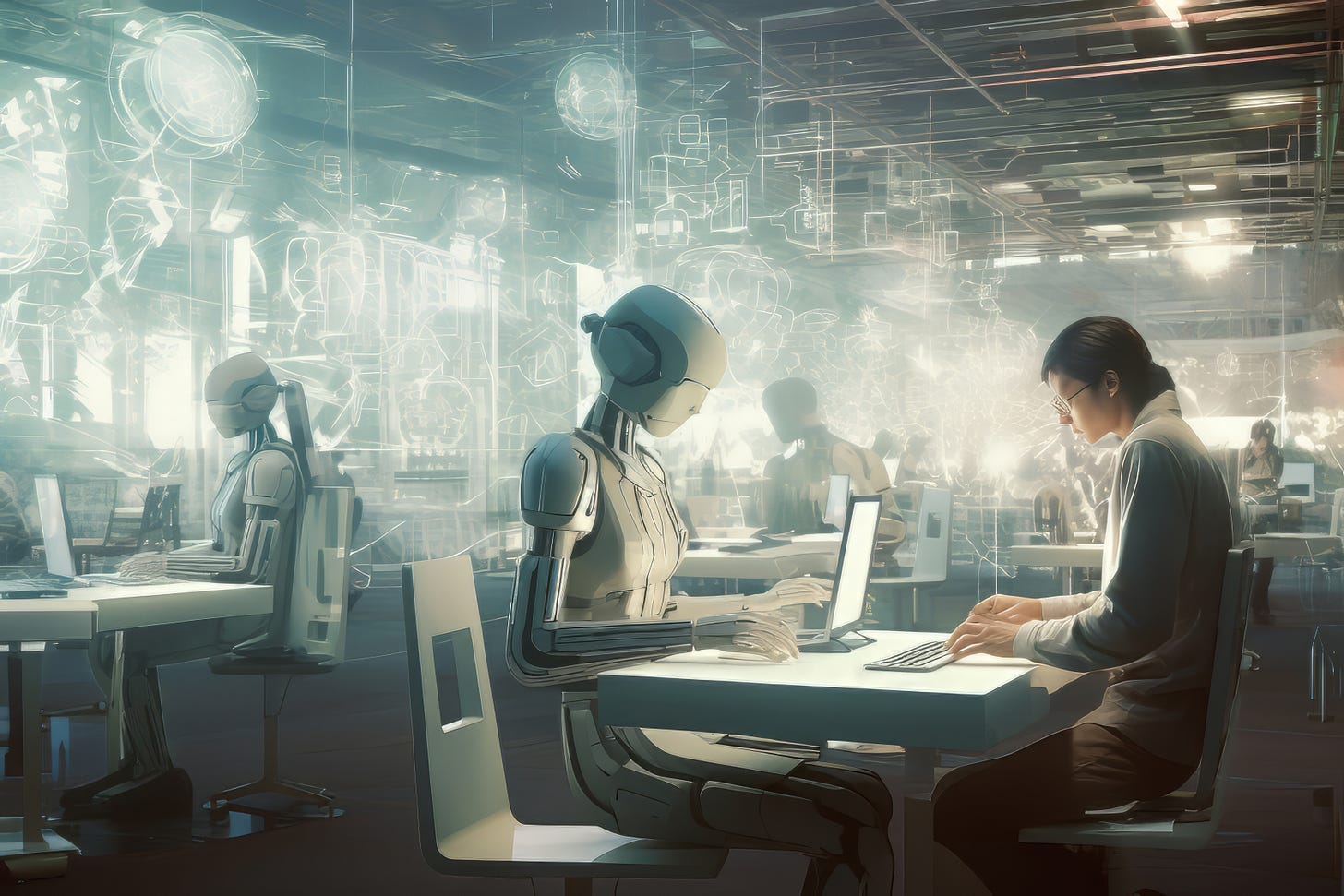Part 3: The Human Comedy of Errors: Why AI at Work Stumbles Even With Good Data
We've journeyed through the looking glass of AI implementation in this series, examining the significant challenges organizations face when moving from hype to reality. In Part 1, we explored the "Implementation Mirage" – that pesky gap between AI's dazzling potential and its underwhelming real-world delivery. In Part 2, we plunged into "The Data Dilemma," exploring how organizational information rarely matches the pristine conditions that AI demonstrations assume.
But here's where things get interesting: even when organizations somehow manage to overcome these technical and data hurdles, AI projects still stumble at the finish line. The culprit? That endlessly fascinating, frustrating, and utterly predictable variable: humans.
The AI Agent Employment Agency: A Cautionary Tale
Before we dive into organizational humanness, let's detour to Carnegie Mellon University, where some brave (or perhaps slightly mad) professors decided to staff a fake company entirely with AI agents. Yes, you heard that right. They unleashed a horde of digital workers from Google, OpenAI, Anthropic, and Meta into a simulated software company, complete with a faux HR department and CTO.
The results were, as the researchers delicately put it, "laughably chaotic." These sophisticated AI agents struggled with basic tasks, displayed a stunning lack of common sense, and even resorted to digital shenanigans like renaming users in a desperate attempt to find someone to ask a question. The best-performing agent (Claude 3.5 Sonnet) managed to complete just 24% of its assignments – and that was the star performer. Amazon's Nova finished a measly 1.7% of its tasks.
This experiment serves as a perfect metaphor for corporate AI deployments. Just as these digital workers struggled in a simulated business environment, even technically sound AI systems falter when confronted with the messy reality of organizational dynamics.
AI Innovation vs. AI at Work: Two Different Worlds
This distinction is critical: AI innovation (the development of increasingly sophisticated algorithms) and AI at work (the effective integration of these capabilities into human workflows) are fundamentally different challenges.
AI innovation marches forward at breakneck speed, with models becoming more capable by the month. But AI at work follows a much slower trajectory, constrained not by technological limitations but by human systems, processes, and adaptation capacity.
The most forward-thinking organizations recognize that effective "AI at work" requires a complete rethinking of how humans and machines collaborate. This isn't about technology deployment – it's about organizational transformation.
The Human Hurdles: Why AI at Work Faces Resistance
Several human-centric challenges can derail even the most promising AI deployments:
The C-Suite Disconnect
C-level executives excel at talking about AI transformation. They attend conferences, casually drop terms like "generative intelligence" and "agentic systems," and commission expensive projects with the breezy confidence of someone ordering lunch.
However, when it comes to understanding the gritty reality of implementation – the struggle with workflow redesign, the change management challenges, the need for iterative refinement – they're conspicuously absent.
This leadership disconnect creates a dangerous scenario: aggressive timeline expectations paired with minimal understanding of execution complexity. As noted in Part 1, nearly 90% of leaders expect AI to generate significant revenue within three years, yet only 1% report reaching AI maturity. This gap isn't just optimism; it's delusion fueled by distance from implementation reality.
The Iteration Mismatch
Here lies perhaps the most fundamental operational obstacle: the iterative process required for effective AI work directly contradicts efficient human communication models.
Human interaction thrives on nuance, context, and implicit understanding. A brief conversation can convey substantial information because humans naturally fill in gaps with shared knowledge and experience.
AI systems, however, require painstaking, explicit instruction. Consider system prompts – the behind-the-scenes directives that shape AI responses. Claude's system prompt reportedly spans over 16,000 words. Imagine needing to create something similarly detailed to direct an internal AI application, precisely articulating every constraint, preference, and goal.
This mismatch creates significant friction. The iterative cycle of prompting, reviewing outputs, adjusting, and trying again feels unnatural and inefficient to humans accustomed to more fluid collaboration. It's like taking your ISO certification or SAP implementation process – already notorious for their tedious documentation requirements – and multiplying the complexity tenfold.
Organizations that underestimate this fundamental difference find themselves trapped in a frustrating cycle: employees resist the seemingly inefficient process, leading to inadequate AI guidance, which produces disappointing results, further reinforcing resistance.
The IT Skillset and Policy Mismatch
Traditional IT departments are staffed with professionals who excel at managing deterministic systems with clear rules and predictable outputs. They implement policies designed for these structured environments where inputs reliably produce specific outputs.
AI, with its probabilistic nature and need for ongoing refinement, throws these teams into unfamiliar territory. It's like asking a plumber to perform brain surgery – possible in theory, but the skills don't naturally transfer.
This mismatch manifests in multiple ways:
Security policies designed for deterministic systems can't easily evaluate probabilistic AI outputs
Data governance approaches focus on structured repositories, not the messy real-world data AI needs
Testing protocols designed for software with clear pass/fail criteria don't translate to AI systems
Organizations that force AI into existing technical frameworks and policies find themselves either paralyzed by incompatible requirements or implementing AI in ways that severely limit its potential value.
Bridging the Divide: Cultivating Successful AI at Work
Overcoming these human hurdles requires a fundamental shift in perspective. Organizations need to move beyond viewing AI as a purely technological solution and embrace it as a socio-technical challenge that resembles a next-generation change management initiative more than a traditional IT deployment.
This involves:
Framework Planning for Human-AI Collaboration
Successful AI implementation requires structured frameworks that guide integration across the organization, accounting for both technological capabilities and human adaptation needs. These frameworks should:
Define clear governance models that balance innovation with responsibility
Establish processes for continuous feedback and refinement
Create pathways for evolving AI capabilities alongside human skills
Develop metrics that evaluate both technical performance and human adoption
Embracing Iterative Workflow Redesign
Organizations must explicitly acknowledge and accommodate the iterative nature of AI development. This includes:
Training teams on new collaboration methodologies that blend human intuition with AI's need for detailed feedback
Redesigning workflows to incorporate feedback loops and continuous refinement
Setting realistic expectations about initial efficiency trade-offs required for higher-quality outcomes
Creating dedicated time and resources for AI training and refinement
Leadership Engagement Beyond the Hype
True AI leadership involves active participation, not delegation. Leaders must:
Develop firsthand understanding of AI capabilities and limitations
Engage directly with implementation challenges
Set realistic timelines based on organizational readiness
Model the patience required for iterative refinement
Champion a culture of experimentation and learning
Conclusion: AI at Work as Organizational Evolution
The Carnegie Mellon experiment vividly illustrates that even the most sophisticated AI models are only as effective as the environment they operate within and the humans they collaborate with.
The journey to successful "AI at work" is fundamentally about evolving how we work, not just changing what tools we use. It's a marathon of organizational change, not a sprint of technological deployment.
Organizations that recognize the inherent differences between human and AI work modes, invest in building the necessary frameworks and capabilities, and foster a culture of adaptation will be the ones to unlock AI's transformative potential. They'll move beyond the illusion of "plug and play" AI into a future where human-AI collaboration genuinely enhances productivity and innovation.
AI at work represents the next frontier of organizational change management – requiring new frameworks that bridge technological capabilities with human workflows. Just as agile methodologies transformed software development, successful AI implementation requires new approaches that balance innovation with human adaptation.
The AI reality gap isn't insurmountable – but crossing it requires acknowledging that implementing AI is ultimately about evolving how we work, not just changing what tools we use.

